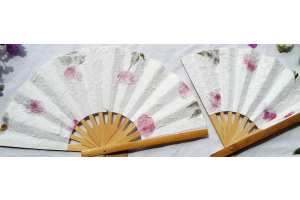Products from Paper Mulberry

Paper mulberry belongs to the MORACCAE family, genus Broussonetia. This plant is a perennial of medium size that grows wild in damp areas in almost every region of Thailand. Its name varies according to where it is found. In the north and northeast, it is called Por Sa, in the west Mo Pee, Mok Pee and in the south Por Fai. Large numbers of them are found in Nan, Lampang, Chiang Mai, Chiang Rai, Phayao, Sukhothai, Khon Kaen, Kanchanaburi, Ratchaburi, and Nakhon Ratchasima. Some rural people use this plant as medicine. For most people, however, it provides good material for paper and handicraft making as its bark yields very tough and long fibers.

Northerners have for hundreds of years made paper from this perennial. History has it that the idea originally came from China. The kind of paper made from this plant is soft in texture but quite strong and durable as well as moth-resistant as it contains no marl. In the past, people used this paper to record the formulae of ancient medicines as well as stories from the Buddhist religion; sometimes they used it as a canvas to paint on; they also used it to wrap things, to make umbrellas, fans, flags and dress patterns. Since 1979 the DIP has helped initiate the development of new products from this mulberry paper. Encouragement has also been given to affect continuous production for the market. At the same time experiments have been conducted to make new articles. The department, in addition, invented the bashing machine to speed up bashing. This helps to shorten the preparation process of the plant and leads to increased production thereby meeting demands both at national and international levels.







